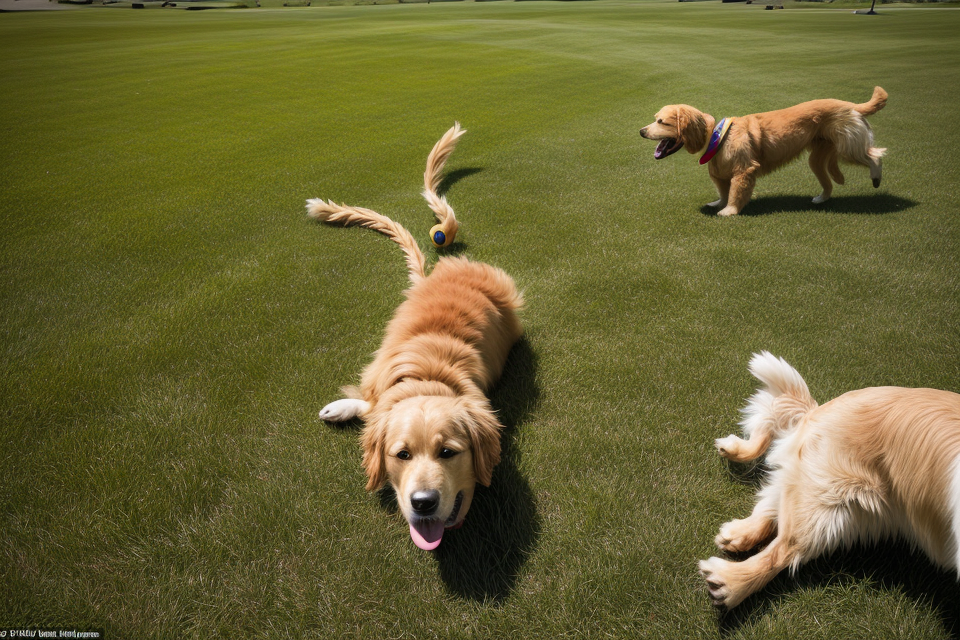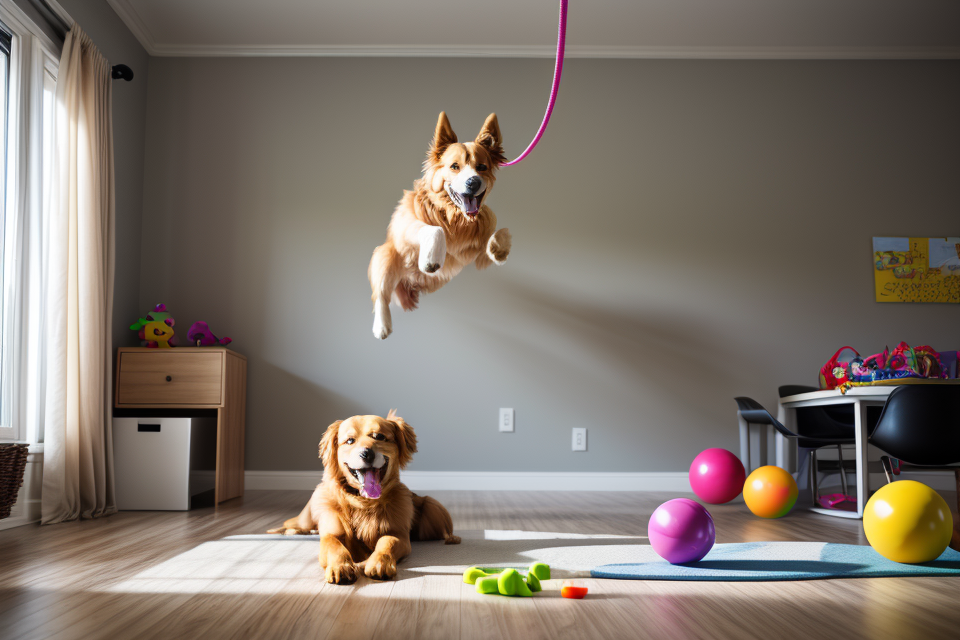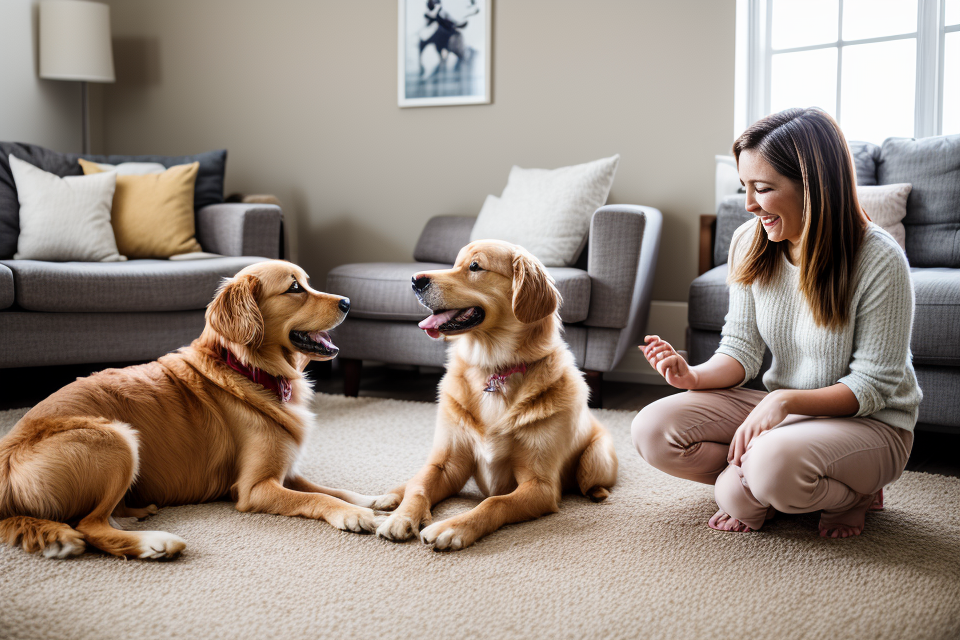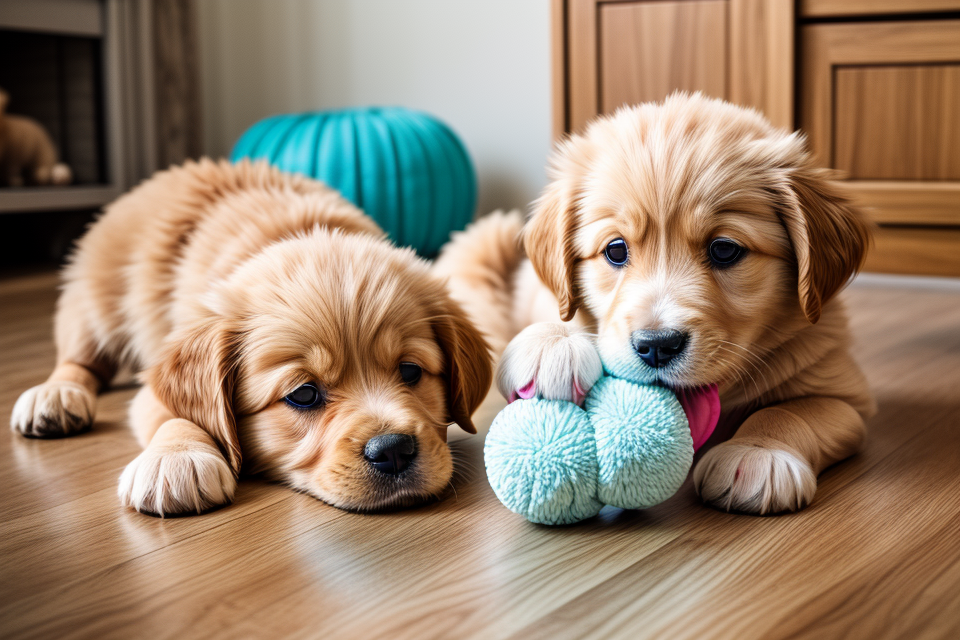Dogs are known to be man’s best friend, and for good reason. They are loyal, loving, and always up for a good time. But even the best of dogs can be a handful if they are not properly trained. One of the most effective ways to train a dog is through the use of toys. In this article, we will explore the various techniques for training your dog with toys, and how you can make the most out of this fun and interactive training method. So, grab a toy and let’s get started!
The Importance of Using Toys in Dog Training
Benefits of Using Toys in Dog Training
- Mental Stimulation: Dogs are naturally curious and love to play. Using toys in training sessions provides mental stimulation for your dog, keeping their mind active and preventing boredom. This is especially important for high-energy breeds that need a lot of exercise to stay happy and healthy.
- Positive Reinforcement: Positive reinforcement is a training technique that involves rewarding desired behavior. By giving your dog a toy as a reward for good behavior, you are reinforcing the behavior and encouraging your dog to repeat it. This technique is a key component of effective dog training and can help to shape desirable behavior over time.
- Behavior Modification: Dogs can benefit from behavior modification training to address problem behaviors such as barking, chewing, or digging. Using toys in training sessions can be an effective way to redirect your dog’s attention away from undesirable behaviors and towards more positive ones. For example, if your dog is chewing on your shoes, you can give them a chew toy as a replacement and reward them for chewing on that instead. Over time, your dog will learn that chewing on shoes is not acceptable behavior.
Types of Toys for Dog Training
Dogs are naturally playful creatures, and incorporating toys into their training is an effective way to keep them engaged and motivated. There are several types of toys that can be used in dog training, each with its own unique benefits.
- Interactive toys: These toys are designed to stimulate mental and physical activity in dogs. Examples include puzzle toys that require dogs to figure out how to get a treat, and tug toys that can be used for play and training.
- Chew toys: Chew toys are great for satisfying a dog’s natural desire to chew, and can also help reduce destructive chewing behavior.
- Plush toys: Plush toys are soft and cuddly, and can be used to provide comfort and relaxation for dogs. They can also be used as rewards during training.
- Fetch toys: Fetch toys are perfect for dogs who love to play fetch, and can be used to improve obedience and retrieve skills.
By incorporating a variety of toys into your dog’s training, you can keep them engaged and motivated while also reinforcing desired behaviors.
Understanding Your Dog’s Play Style
Observation
One of the most effective ways to determine your dog’s play style is through observation. By carefully watching your dog play with toys, you can gain valuable insights into their preferences and behavior. Here are some tips for observing your dog during playtime:
- Set aside some time to observe your dog playing with toys. It’s best to do this when your dog is in a calm and relaxed state, so they won’t be too excited or overwhelmed.
- Take note of which toys your dog seems to enjoy the most. Do they prefer squeaky toys, plush toys, or interactive toys that require more mental stimulation?
- Pay attention to your dog’s play style. Do they like to play tug-of-war, chew on toys, or simply carry them around?
- Consider the size and type of toys your dog prefers. Some dogs enjoy smaller, more manageable toys, while others prefer larger ones.
- Observe your dog’s body language and behavior during playtime. Are they excited and energetic, or do they seem bored or disinterested?
By carefully observing your dog’s behavior during playtime, you can gain a better understanding of their preferences and tailor your training techniques accordingly. This can help make training sessions more enjoyable and effective for both you and your dog.
Application
Choosing the right toys is essential to keeping your dog engaged and motivated during training sessions. Consider the following factors when selecting toys for your dog:
- Size: Choose toys that are appropriate for your dog’s size and strength. A small dog may enjoy a soft, squeaky toy, while a larger dog may prefer a sturdy, durable ball.
- Material: Different dogs have different preferences when it comes to the materials of their toys. Some dogs prefer rubber or plastic, while others may prefer toys made from rope or fabric.
- Type: There are many different types of toys available for dogs, including balls, frisbees, and stuffed animals. Consider your dog’s interests and abilities when choosing a toy.
Incorporating variety into your dog’s training sessions can also help to keep them engaged and motivated. Try rotating toys frequently, or offering a selection of toys to choose from during training sessions. You can also try switching up the training location or incorporating different training techniques to keep things interesting for your dog.
Techniques for Training with Toys
Positive Reinforcement
When it comes to training your dog with toys, positive reinforcement is a highly effective technique. Here’s how it works:
- Reward good behavior with toy playtime: When your dog exhibits desired behavior, such as sitting calmly or staying in one place, reward them with playtime with their favorite toy. This reinforces the behavior and encourages your dog to repeat it.
- Gradually increase duration and frequency of playtime: As your dog becomes more proficient in their desired behavior, gradually increase the duration and frequency of playtime rewards. This helps to maintain your dog’s motivation and encourages them to continue exhibiting the desired behavior.
By using positive reinforcement, you can train your dog to associate desired behaviors with positive outcomes, making it more likely that they will repeat those behaviors in the future.
Shaping Behavior
Shaping behavior is a technique used in dog training that involves rewarding a dog for small steps towards a desired behavior. This method is based on the principles of operant conditioning, which is a form of learning that occurs through reinforcement and punishment. Here are some tips for shaping behavior in your dog using toys:
Start with small steps
The first step in shaping behavior is to start with small, manageable behaviors that are easy for your dog to perform. For example, if you want your dog to fetch a toy, you might start by asking him to pick up a toy and hold it in his mouth. This behavior is known as the “pick up” cue, and it’s a small step towards the ultimate goal of fetching the toy.
Build on previous behaviors
Once your dog has mastered a small behavior, you can build on it by asking for a slightly more complex behavior. For example, if your dog has learned to pick up a toy, you can ask him to bring it to you. This is known as the “bring” cue, and it’s a small step towards the ultimate goal of fetching the toy.
Use high-value toys as motivation
Dogs are highly motivated by toys, and using high-value toys as rewards can be a powerful tool in shaping behavior. When your dog performs a desired behavior, such as picking up a toy, you can reward him with a high-value toy as a reinforcer. This will help to strengthen the desired behavior and encourage your dog to repeat it in the future.
In summary, shaping behavior is a powerful technique for training your dog using toys. By starting with small, manageable behaviors, building on previous behaviors, and using high-value toys as motivation, you can shape your dog’s behavior and teach him new skills.
Problem-Solving
Using toys to distract your dog from unwanted behaviors is an effective problem-solving technique in dog training. By providing your dog with a toy as a reward for good behavior, you can teach them to associate positive behaviors with the toy. This can help to reduce unwanted behaviors such as barking, jumping, or digging.
Another way to use toys for problem-solving is to teach alternative behaviors to replace unwanted ones. For example, if your dog likes to chew on furniture, you can provide them with a chew toy as a replacement. By teaching your dog to chew on the toy instead of the furniture, you can prevent damage to your home and teach your dog a new, positive behavior.
To effectively use problem-solving techniques when training your dog with toys, it’s important to make sure that the toy is highly desirable to your dog. This will help to motivate them to engage in the desired behavior and make the training process more effective. Additionally, it’s important to be consistent in your use of the toy as a reward, as this will help your dog to understand the connection between the toy and the desired behavior.
Training Session Tips
Frequency
When it comes to training your dog with toys, the frequency of training sessions is crucial. Here are some tips to consider:
- Train multiple times per day for short periods: Dogs have short attention spans, so it’s essential to keep training sessions short and sweet. By training multiple times per day for short periods, you can keep your dog engaged and prevent boredom.
- Increase training time gradually: As your dog becomes more comfortable with the training sessions, you can gradually increase the duration of each session. This will help your dog build endurance and maintain focus throughout the training process.
By following these frequency tips, you can ensure that your dog stays engaged and motivated during training sessions while avoiding burnout or boredom.
Environment
Choosing the right environment for your dog’s training session is crucial for the success of the training process. Here are some tips to keep in mind when selecting the environment for your dog’s training session:
- Choose a quiet, distraction-free area: The environment should be free from distractions that could divert your dog’s attention away from the training session. A quiet room or area with minimal noise and no other dogs or people around is ideal. This will help your dog to focus on the task at hand and prevent any unwanted distractions.
- Use familiar toys for consistency: Using familiar toys for the training session will help your dog to associate the toys with the training process and make it easier for them to understand what is expected of them. Using the same toys each time will also help to reinforce the lessons learned during previous sessions. Additionally, using familiar toys will help to build a positive association with the training process, making your dog more eager to participate in future sessions.
Consistency
- Use the same toys and commands: It is essential to use the same toys and commands during each training session. This consistency helps your dog understand what is expected of them and enables them to associate the toys and commands with specific actions. For example, if you always use a red ball as a reward for a specific behavior, your dog will learn to expect the red ball when they perform that behavior.
- Reinforce good behavior consistently: Consistency is also crucial when it comes to reinforcing good behavior. When your dog exhibits the desired behavior, you should reward them immediately and consistently. This reinforcement strengthens the connection between the behavior and the reward, making it more likely that your dog will repeat the behavior in the future. Additionally, being consistent with your reinforcement helps your dog understand what behaviors are expected of them and what behaviors will result in rewards.
Common Challenges and Solutions
Toy Over-Priority
When training your dog with toys, it’s essential to ensure that they don’t become overly fixated on specific toys or develop an excessive interest in playtime. This can lead to a lack of focus during training sessions and hinder your dog’s progress. Here are some effective techniques to overcome this challenge:
- Rotate toys: Regularly switching up the toys you use during training sessions can help maintain their value and prevent your dog from becoming bored or uninterested. This also encourages them to remain engaged and responsive during training.
- Limit playtime for non-compliance: If your dog is not showing progress or consistently disrupting training sessions, consider reducing playtime as a form of positive reinforcement. By making playtime contingent on good behavior, your dog will be more likely to stay focused and engaged during training.
It’s important to note that every dog is unique, and these techniques may need to be adjusted based on your dog’s individual needs and personality. Be patient and consistent in your approach, and remember that positive reinforcement is key to successful training with toys.
Short Attention Span
Dogs, especially puppies, have a relatively short attention span, which can make training sessions challenging. However, there are several effective techniques that can help overcome this challenge and make training sessions more enjoyable for both you and your dog.
- Keep training sessions short: It’s essential to keep training sessions short and sweet, especially when your dog’s attention span is limited. Aim for short bursts of training, no longer than 5-10 minutes at a time, and take regular breaks to prevent boredom and maintain your dog’s focus.
- Increase playtime as attention span improves: As your dog’s attention span improves, you can gradually increase the length of training sessions and introduce more complex training exercises. Additionally, incorporating playtime into training sessions can help keep your dog engaged and motivated, making training more enjoyable for both you and your dog.
By using these techniques, you can help your dog develop a longer attention span and make training sessions more effective and enjoyable for both you and your furry friend.
Resistance to Training
When it comes to training your dog with toys, resistance can be a common challenge. However, there are several effective techniques that can help overcome this obstacle.
- Be patient and consistent: One of the most important things to keep in mind when dealing with resistance to training is to be patient and consistent. Dogs are highly attuned to their environment and can pick up on their owner’s mood and behavior. If you are feeling frustrated or impatient, your dog will likely pick up on this and become more resistant to training. By remaining calm and patient, you can help your dog feel more comfortable and willing to participate in training sessions.
- Seek professional help if needed: If you are having trouble overcoming resistance to training, it may be helpful to seek professional help. A professional dog trainer can help you identify the root cause of your dog’s resistance and provide you with effective techniques for overcoming it. They can also help you develop a training plan that is tailored to your dog’s individual needs and personality.
In addition to these techniques, it’s also important to keep in mind that every dog is different and what works for one may not work for another. It may take some trial and error to find the best techniques for training your dog with toys. However, with patience, consistency, and professional help if needed, you can help your dog become a confident and well-behaved companion.
FAQs
1. What is the best way to introduce a new toy to a dog?
When introducing a new toy to a dog, it’s important to do so in a controlled manner. Start by presenting the toy to the dog in a safe and neutral location, such as a room with no distractions. Allow the dog to sniff and explore the toy, and reward them with praise and treats when they show interest or curiosity. Gradually increase the dog’s exposure to the toy, and eventually incorporate it into playtime and training sessions.
2. How often should I play with my dog using toys?
It’s recommended to play with your dog using toys for at least 15-30 minutes per day, depending on the breed, age, and energy level of your dog. Playing with toys can help satisfy your dog’s natural instinct to chase, chew, and fetch, and can also strengthen the bond between you and your dog. Additionally, playing with toys can help provide mental stimulation and reduce boredom, which can help prevent destructive behavior.
3. How do I choose the right toys for my dog?
When choosing toys for your dog, it’s important to consider their size, strength, and preferences. For small dogs, choose toys that are soft and easy to carry, such as stuffed animals or squeaky toys. For larger dogs, choose toys that are durable and able to withstand their powerful jaws, such as rubber balls or ropes. Additionally, consider your dog’s favorite type of play, such as fetch or tug-of-war, and choose toys that are appropriate for those activities.
4. How do I teach my dog to play with toys?
To teach your dog to play with toys, start by presenting the toy to them in a neutral location and allowing them to sniff and explore it. Once they show interest in the toy, encourage them to pick it up and carry it around. You can also initiate play by tossing the toy and encouraging your dog to retrieve it. Gradually increase the level of difficulty and challenge, such as hiding the toy or incorporating it into obedience training.
5. How do I prevent my dog from becoming bored with their toys?
To prevent your dog from becoming bored with their toys, rotate their toys regularly and keep them in a variety of locations. You can also hide the toys in a designated “toy box” and encourage your dog to use their problem-solving skills to find them. Additionally, try incorporating different types of play, such as fetch, tug-of-war, and scent work, to keep things interesting and stimulating for your dog.



